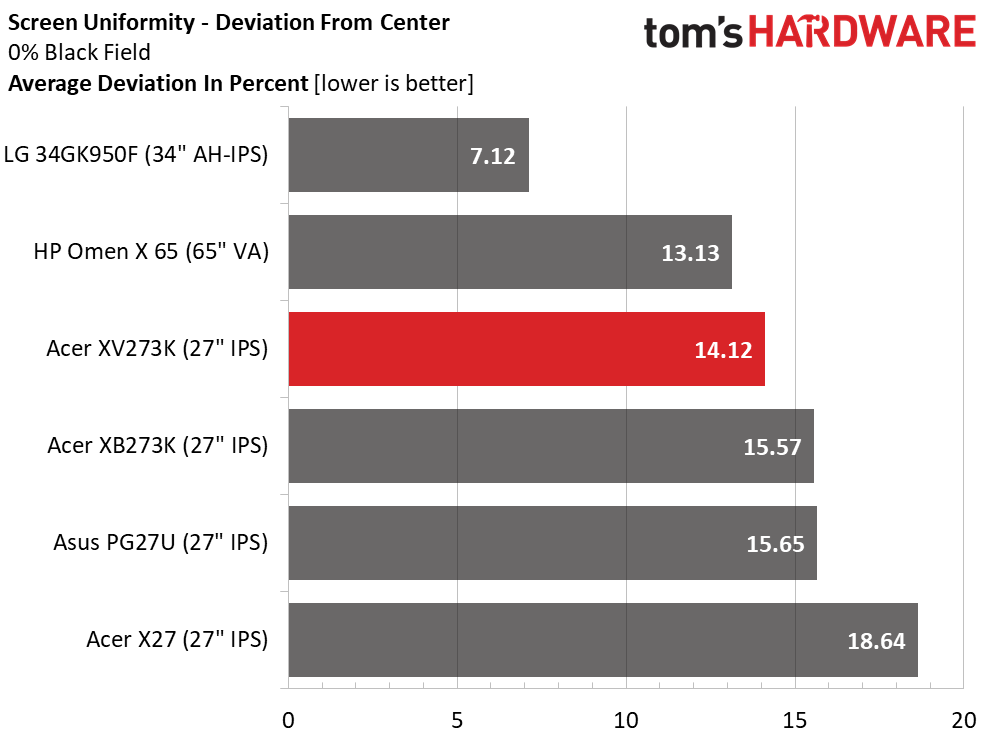Acer Nitro XV273K Gaming Monitor Review: 4K at 144Hz Gets Cheaper
Why you can trust Tom's Hardware
Viewing Angles, Uniformity, Response and Lag
Viewing Angles
The XV273K uses an AHVA (Advanced Hyper-Viewing Angle) variant of IPS technology. Even though it exhibits the typical IPS green color shift to the sides, detail and brightness are far better than average. Light drops by no more than 30 percent, and you can still clearly see every step in the pattern. The top-down view is improved over regular IPS as well, with good detail and only a slight blue hue visible.
Screen Uniformity
To learn how we measure screen uniformity, click here.
We’ve seen reports online of this monitor’s light bleed issues, along with some rather dramatic photographs. Our sample did not display this behavior. Though it didn’t ace the uniformity test, it performed within acceptable limits.
While its 14.12 score is a bit below average, the visible issues here are slight. The culprit lies in the screen corners, where we can see a bit of hotspotting. In our case, there were no visible issues in gaming or video content unless there were black letterbox bars, like you’d see when watching a movie. There, we could see slight bleed in the corners but not within the movie frame.
Pixel Response and Input Lag
Click here to read up on our pixel response and input lag testing procedures.


Once you hook up two DisplayPort cables, the Nitro XV273K runs happily at 144Hz at full bandwidth. That extra color depth doesn’t affect speed in the slightest. The monitor still matched the typical 144Hz response time of 7ms and posted a very low 37ms total lag score. We doubt any gamers will complain about the responsiveness of this display. It moves smoothly and quickly, regardless of how fast you flick the mouse. This panel will appeal to gamers of all skill levels.
Image Credits: Tom’s Hardware
MORE: Best Gaming Monitors
Get Tom's Hardware's best news and in-depth reviews, straight to your inbox.
MORE: How We Test Monitors
MORE: All Monitor Content
Current page: Viewing Angles, Uniformity, Response and Lag
Prev Page HDR Performance Next Page Conclusion
Christian Eberle is a Contributing Editor for Tom's Hardware US. He's a veteran reviewer of A/V equipment, specializing in monitors. Christian began his obsession with tech when he built his first PC in 1991, a 286 running DOS 3.0 at a blazing 12MHz. In 2006, he undertook training from the Imaging Science Foundation in video calibration and testing and thus started a passion for precise imaging that persists to this day. He is also a professional musician with a degree from the New England Conservatory as a classical bassoonist which he used to good effect as a performer with the West Point Army Band from 1987 to 2013. He enjoys watching movies and listening to high-end audio in his custom-built home theater and can be seen riding trails near his home on a race-ready ICE VTX recumbent trike. Christian enjoys the endless summer in Florida where he lives with his wife and Chihuahua and plays with orchestras around the state.
-
dbrees Honestly, why do people even go for monitors with HDR 400, the spec does not have zone brightness, only HDR 600 and up do. Without zone brightness what is the point? The only thing I've heard about HDR 400 is that it is better than nothing, but is that worth this kind of premium?Reply -
bigpinkdragon286 While this may be a beautiful screen for gaming, the setups that can even power it at rates exceeding what lower cost screens can achieve are barely measured in single digit percentages. I suspect the market for these things is horrendously small, as in a minuscule percent of an already tiny percent of gamers.Reply -
shemsureshot I bought this monitor a few weeks ago directly from acer thanks to a promotion where I managed to get a decent discount. It is probably the best monitor I have ever owned and the HDR effect seems pretty decent, while standard range looks phenomenal and gsync works brilliantly. I can’t really fault it. I’ve read a few complaints online about 400 nit HDR, all I can say to them is this is a 27 inch monitor, designed to be used at close range than say a 60 inch tv made to be viewed from a distance, in that case I would agree 400 nits is too low.Reply -
Ninjawithagun IMHO, 27-inch 4K gaming monitors are pointless due to the pixel density and normal viewing distance of 2-3 feet. I've seen 27-inch 4K and 27-inch QHD (2560 x 1440) monitors side-by-side, and there really isn't much of a difference. As an owner of a 32-inch 4K gaming monitor, I know that's the sweet spot for the pixel density and viewing distance. I'm just have to wait for the 32-inch version of these monitors to be released later.Reply

